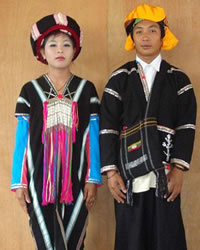Riang Lai in Myanmar (Burma)

Photo Source:
Asia Harvest-Operation Myanmar
|
Send Joshua Project a map of this people group.
|
| People Name: | Riang Lai |
| Country: | Myanmar (Burma) |
| 10/40 Window: | Yes |
| Population: | 13,000 |
| World Population: | 13,000 |
| Primary Language: | Riang Lai |
| Primary Religion: | Ethnic Religions |
| Christian Adherents: | 0.10 % |
| Evangelicals: | 0.10 % |
| Scripture: | Portions |
| Ministry Resources: | Yes |
| Jesus Film: | No |
| Audio Recordings: | Yes |
| People Cluster: | Karen |
| Affinity Bloc: | Tibetan-Himalayan Peoples |
| Progress Level: |
|
Introduction / History
This fascinating tribe is also known to other ethnicities as the Yinchia—a name given to them by the Burmese, which means “Striped Karen.” The Riang Lai are related by ancestry and culture to the Riang Lang, but their languages are different. Both groups are historically related to the Palaung, but over the centuries their languages and customs diverged, making them separate ethnicities today. Traditionally, the two Riang tribes occupied different social and geographic space and have their own clothing styles. They are not related to the identically named Riang tribe of northeast India and Bangladesh.
Riang Lai people inhabit several villages in northern Shan State within Namsan and Mantong Townships in the Palaung Self-Administered Zone. In Namsan, Riang people occupy the villages of Maemunglon, Saimon, Sam Kha, and Kon Pung. Besides the?dominant Palaung people, Namsan is also populated by Karen, Lisu, and Shan?people, and by ethnic Indians and Chinese. The 1931 census of Burma returned 2,677 "Yangsek" people, who are presumably today's
Riang Lai and Riang Lang came from the same historical roots as the Palaung people, but over generations their languages diverged and are no longer intelligible with Palaung. Riang Lai has been categorized as an “endangered” and “decreasing” language. Although all Riang Lai adults speak their language, many young people now prefer to use Shan or Burmese.
The region inhabited by the Riang Lai has a very long history, dating back to the founding of the Dutthavati State in 58 BC. During the Sino-Burmese War (1765-1769), Chinese imperial troops invaded the area, overrunning town after town. By the 1880s, the various Shan princes had submitted to the British colonial rulers. Namsan served as the capital of?Tawngpeng, a?Palaung?substate of the?Shan States in British Burma. The main Riang Lai area was incorporated into the newly formed Palaung Self-Administered Zone in 2012, but tensions between the residents and the Burmese military simmered. In December 2023 Namsan fell under the control of the?Ta'ang National Liberation Army?after two weeks of fierce fighting, despite a Chinese-backed ceasefire agreement between the TNLA and the military junta.
What Are Their Lives Like?
Noted for their predominantly black clothing, which is adorned by colorful tassels and headdresses, Riang Lai people are also easily identified by “their custom of men and women capping their four front teeth in gold, which is then inlaid with ruby and green jade. This is regarded as a mark of great beauty.”
What Are Their Beliefs?
Awis are strongly Ethiopian Orthodox Christians and very resistant to any form of Protestant Christianity. The Awi people accepted Orthodox Christianity hundreds of years ago.
What Are Their Needs?
Awis need a strong commitment to Jesus Christ that will only come with revival.
Prayer Points
Pray for wide distribution of gospel recordings and other resources among the Riang Lais.
Pray for their hearts to be opened to their need for Jesus Christ.
Pray that soon Riang Lai disciples will make more disciples.